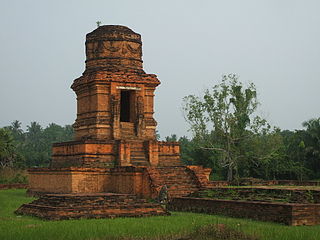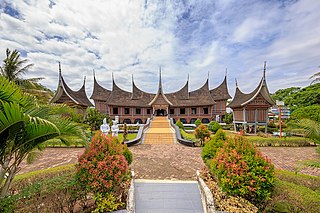Related Research Articles

West Sumatra is a province of Indonesia. It is located on the west coast of the island of Sumatra and includes the Mentawai Islands off that coast. The province has an area of 42,119.54 km2 (16,262.45 sq mi), with a population of 5,534,472 at the 2020 census. The official estimate at mid 2022 was 5,640,629. West Sumatra borders the Indian Ocean to the west, as well as the provinces of North Sumatra to the north, Riau to the northeast, Jambi to the southeast, and Bengkulu to the south. The province is subdivided into twelve regencies and seven cities. It has relatively more cities than other provinces outside of Java, although several of them are relatively low in population compared with cities elsewhere in Indonesia. Padang is the province's capital and largest city.
A regency, sometimes incorrectly referred to as a district, is an administrative division of Indonesia, directly under a province and on the same level with city (kota). Regencies are divided into districts.

Pagaruyung, also known as Pagarruyung, Pagar Ruyung and, Malayapura or Malayupura, was a kingdom that once stood in the island of Sumatra and the seat of the Minangkabau kings of Western Sumatra. Modern Pagaruyung is a village in Tanjung Emas subdistrict, Tanah Datar regency, located near the town of Batusangkar, Indonesia.

Tanah Datar Regency is a landlocked regency (kabupaten) in West Sumatra province, Indonesia. The regency has an area of 1,336 km2, and had a population of 338,484 at the 2010 Census, which rose to 371,704 at the 2020 Census. The regency seat is the town of Batusangkar. The city of Padang Panjang is also geographically located within the regency but constitutes a municipality of its own.

Adityawarman was a king of Malayapura Suvarnabhumi, and is the successor of the Mauli dynasty based on central Sumatra. He was the cousin of Jayanegara, king of Majapahit from 1309 to 1328, and the grandson of Tribhuwanaraja, king of Melayu Kingdom. Adityawarman was awarded the Senior Minister of Majapahit (wreddamantri) and used this authority to launch Majapahit military expansion plans and conquered east coast region in Sumatra. Adityawarman then founded the royal dynasty of Minangkabau in Pagaruyung and presided over the central Sumatra region to take control of the gold trade between 1347 and 1375.

Hikayat Iskandar Zulkarnain is a Malay epic describing fictional exploits of Alexander the Great (Iskandar), identified with Dhu al-Qarnayn (Zulkarnain), a king briefly mentioned in the Quran. The oldest existing manuscript is dated 1713, but is in a poor state. Another manuscript was copied by Muhammad Cing Sa'idullah about 1830.

Pasaman Regency is a regency (kabupaten) of West Sumatra, Indonesia. It has an area of 3,947.63 square kilometres (1,524.19 sq mi) and had a population of 252,981 at the 2010 Census and 299,851 at the 2020 Census. The regency seat is the town of Lubuk Sikaping.

The Melayu Kingdom was a classical Buddhist kingdom located in Southeast Asia and western Nusantara.
Ananggawarman was a crown prince (yuvaraja) of the Malayapura kingdom, which ruled at the end of the 14th century. The Malayapura kingdom was centered on the Minangkabau Highlands and its territory covers much of central Sumatra. The name Ananggawarman is inscribed on Saruaso II inscription as the son of King Adityawarman. It is not clear when Ananggawarman began to reign in place of his father, but it was written in the History of Ming that the kingdom sent a messenger again to China in 1376.

Dara Jingga, was one of the Malay Dharmasraya princess who was intended to be betrothed to Javanese King Kertanegara of Singasari after the Pamalayu expedition 1275–1293.

The archaeology of Indonesia is the study of the archaeology of the archipelagic realm that today forms the nation of Indonesia, stretching from prehistory through almost two millennia of documented history. The ancient Indonesian archipelago was a geographical maritime bridge between the political and cultural centers of Ancient India and Imperial China, and is notable as a part of ancient Maritime Silk Road.

Adityawarman Museum is a State Museum located in Padang, Western Sumatra. As a State Museum, Adityawarman Museum is officially known as the State Museum of West Sumatra. The museum displays ethnographic collections of items related to the culture of the Province of West Sumatra, particularly the culture of Minangkabau and Mentawai.
Adwayawarman was the father of King Adityawarman of Malayapura kingdom as mentioned in the Kuburajo I Inscription. His alias name was Adwayadwaja, as he was called in the Bukit Gombak Inscription.

Minangkabau Culture Documentation and Information Center is a museum and research center for Minangkabau culture, located in the city of Padang Panjang, West Sumatra, Indonesia. The center building is in the form of a Minangkabau traditional house, with a large garden that slopes up to the main gate.
Akarendrawarman was a ruler of Malayapura kingdom in the Minangkabau plateau. His name was found in the Pagaruyung VII inscription, which is written in Old Malay, his full title is Paduka Sri Maharajadhiraja Srimat Sri Akarendrawarman. In carrying out his administration, he was assisted by various other officials, among others was a minister called Tuhan (lord) Parpatih. The kingdom was mentioned to be located in Parhyangan on Mount Mahameru.
Lubuk Layang inscription, also known as Kubu Sutan inscription, is an inscription found in 1970 in Kubu Sutan, Lubuk Layang, Rao Selatan district, Pasaman Regency, of West Sumatra, Indonesia.

Saruaso II inscription, also previously known as Batusangkar inscription, is one of the inscriptions from the King Adityawarman era. It is currently located at the Fort van der Capellen area, in the courtyard of the old office of the Monuments Preservation Department, in Batusangkar city, West Sumatra, Indonesia. The inscription was previously displayed across in front of the Indo Jalito Building, which was the residence of the Regent of Tanah Datar during the Dutch colonial period. The inscription is written in Old Javanese script and Sanskrit language.

Kuburajo Inscription, also called Kuburajo I Inscription, is one of the many inscriptions left by King Adityawarman of central Sumatra. The inscription was found in Kuburajo village, Lima Kaum district, Tanah Datar Regency, West Sumatra, Indonesia in 1877 besides the main road from Batusangkar city to Padang city. The inscription was registered by N.J. Krom in Inventaris der Oudheden in de Padangsche Bovenlanden. The inscription is written in Sanskrit, and consists of 16 lines. This inscription was lost in 1987, but was rediscovered.

The National Archaeology Research Institute was a research center coordinated under the Agency of Education Standards, Curriculum, and Assessments of Ministry of Education, Culture, Research, and Technology. The research center was one of the oldest state research institution in Indonesia which had been operated since early of 20th century.
References
- ↑ Abidin, Mas'oed (2005). Ensiklopedi Minangkabau. Pusat Pengkajian Islam dan Minangkabau. p. 90. ISBN 9793797231.
- ↑ Andaya, Leonard Y. (2008). Leaves of the Same Tree: Trade and Ethnicity in the Straits of Melaka . ed. berilustrasi. University of Hawaii Press. pp. 87–88. ISBN 0824831896.
- ↑ Schnitger, F. M. (1937). The Archaeology of Hindoo Sumatra. Leiden: Brill Archive. p. 13.
- ↑ Kalpataru, Masalah 9. Lembaga Purbakala dan Peninggalan Nasional, Pusat Penelitian Purbakala dan Peninggalan Nasional (Indonesia). 1990. p. 229.
- ↑ Kozok, Uli (2015). A 14th Century Malay Code of Laws: The Nitisarasamuccaya. Institute of Southeast Asian Studies. p. 39. ISBN 9814459747.